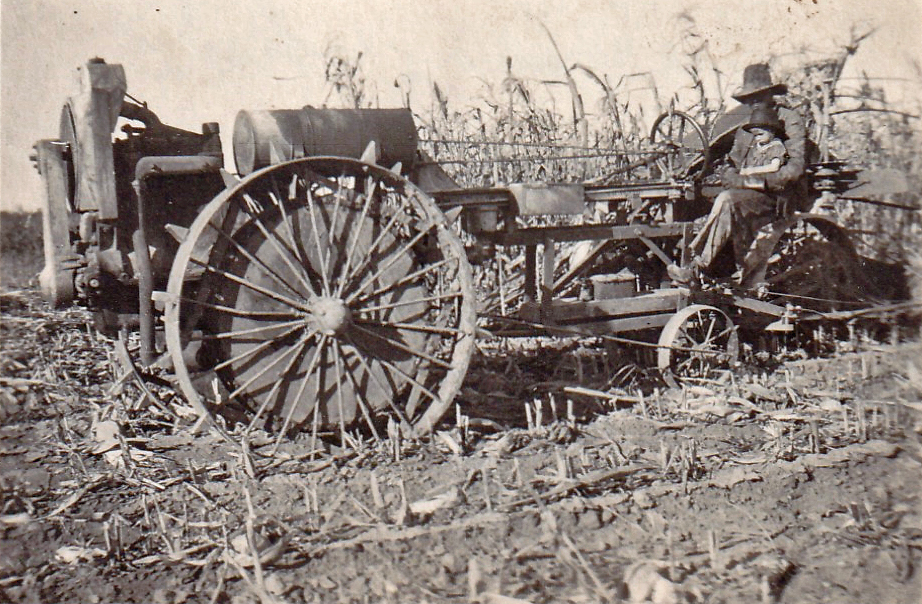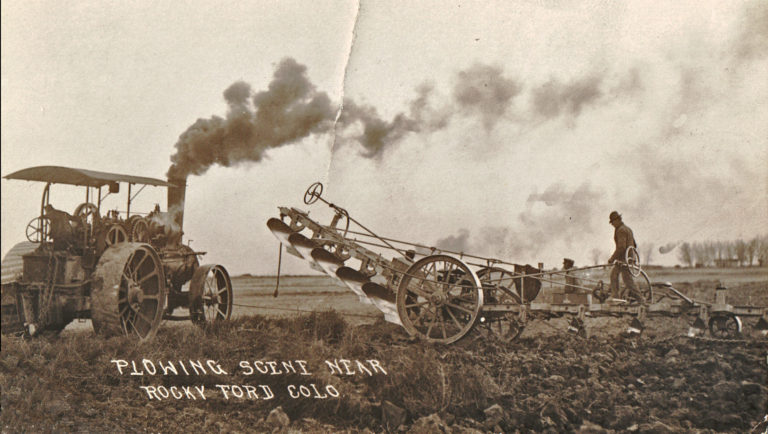This photo shows a farmer with his son, “John D,” on a Moline Universal Model D tractor in a cornfield outside of Rocky Ford. This model, manufactured by the Moline Plow Company (later to become the Moline Implement Company) of Moline, Illinois, came out in 1918. For some years, Moline had been working with the Universal Tractor Manufacturing Company in Columbus, Ohio, manufacturing plows for that company’s Model 10-12 Motor Cultivator. Wanting to get into the tractor business themselves, Moline would purchase Universal Tractor in 1915.
The Model D’s engine and transmission were mounted above the 52-inch diameter drive wheels. The wheels could be equipped with six-inch wide rim extensions, increasing their contact area from 8 to 14 inches, and the tractor was equipped with a differential lock if extra traction were needed. The latter would lock the two axles so the wheels would turn in unison.
At the YouTube site https://www.youtube.com/watch?v=KF4HYswYEKs brothers Kent and Karl Jansen describe the differences between the Moline Universal Model C (the Model D’s predecessor) and the Model D at the 2019 Universal Moline Reunion in Geneseo, Illinois.
As Kent points out, the Model C had a 2-cylinder, 2-cycle engine which ran on a mixture of oil and gasoline. Apparently, the oil would not burn off completely and the excess ended up in the crankcase. This meant the operator had to periodically drain the crankcase of accumulated excess oil as well as re-fill the oil lubricator. Kent also points out that if you didn’t have the Model C’s transmission engaged, you would have no brakes, and the Model C was started with a crank, which would operate properly only after the operator lined up 8 locations behind the drive wheel.
The Model D featured a 4-cylinder, 4-cycle engine. Its improvements over the C eventually included an electric starter/battery ignition and two lights for night work, one in the front pointing forward and one in the rear pointing down onto the implement. In the photo it’s impossible to tell if there is a rear light, but the absence of a front, forward-pointing light may indicate that this tractor was a predecessor of the fully upgraded D.
In exhibiting the Model D, Karl points out the interesting fact that, because the Model D’s engine was mounted off-center (presumably for engineering design reasons), the initial models would tip over in the direction of the engine. To fix this, Moline added concrete weights to the front drive wheels. In the case of the tractor Karl is exhibiting, note the concrete “hubcap” on the right front wheel. Likewise, note the “hubcap” on the left front wheel of the tractor in the photo.
Moline claimed its Model D could take the place of six horses. An attractive feature of the tractor was that it was compatible with horse-drawn implements.
In 1924, Moline exited the tractor business due to financial difficulties, selling its Universal Tractor plant to International Harvester. In 1929, the now-smaller Moline company merged with the Minneapolis Steel and Machinery Company and with the Minneapolis Threshing Machine Company, and the result was the Minneapolis-Moline Power Implement Company.
REFERENCES:
- “Cylinder lubrication two-stroke engines – an overview,” ShipInSight at https://shipinsight.com/articles/cylinder-lubrication-two-stroke-engines-an-overview/
- “How to Use Differential Lock in Tractor,” August 21, 2021, KhetiGaadhi at https://khetigaadi.com/blog/tractor-differential-lock/
- “The Moline-Universal Model D: Early entry into motor-farming market marked by innovation,” Farm Collector, April 1, 2005, at https://www.farmcollector.com/tractors/the-moline-universal-model-d-early-entry-into-motor-farming-market-marked-by-innovation/
- “The REVOLUTIONARY Moline Universal Tractor – Learn About Some Of Its Unique Features!,” Classic Tractor Fever Tv, www.youtube.com at https://www.youtube.com/watch?v=KF4HYswYEKs
- “2-4 Stroke Engine Applications and Lubrication Needs,” The Newsstand, Amsoil at https://www.amsoil.com/newsstand/2-and-4-stroke-oils/articles/applications-and-lubrication-needs/


